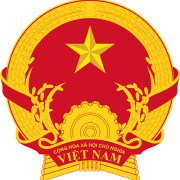
A robot enters a kitchen and a few minutes later brings drinks to diners. Many forms of payment and contactless transactions are quietly coming to life. And, going beyond this is the formation of smart cities.
One morning in November 2021, Tran An left his home at 7am and called at a newly opened coffee shop in District 7 in HCM City on his way to the office. No staff appeared except for a robot approaching An’s table. He used his smartphone to scan the QR code on the robot's body. The list of drinks was shown and he chose the dish and placed the order on the phone screen. Immediately, the staff in the kitchen received the order and started processing the drink. The robot went into the kitchen and a few minutes later brought the drink to An.
“I was surprised the first time seeing the robot here. This was very convenient. Limiting face-to-face communication is a good way to ensure the safety of both customers and employees,” An said.
Ms. Thanh Mai, from District 4, said that it was convenient to pay for drinks via e-wallets after seeing the phone number of the coffee shop owner printed on a table.
A representative of the robot supplier, Mr. Nguyen Van Tien, Director of TD - My Nam Nguyen Company, said that artificial intelligence robots have recently appeared in the Vietnamese market. The automation device can replace 2-4 employees with simple tasks.
The coffee shop is able to save staff training costs as well as reduce the number of waiters. The robot can also carry used glasses and plates on trays, transferring them to the washing area.
The robot has a sensor, so when it encounters an obstacle, it will stop, emit a warning sound and find an alternative way to move. In the future, the robot can be installed with a Vietnamese voice interaction software to guide customers to an empty table. This type of robot is priced from 100-300 million VND/unit depending on the model and technology features.
Race for cashless payments
Robots serving coffee is a method used in combination with cashless payments, creating conveniences for service users. In 2021, many distribution systems entered the race for cashless payments.
At Aeon Tan Phu supermarket in Tan Phu district, Ho Chi Minh City, Ms. Minh Phuong checked the prices of the goods, displayed on the screen after the staff scanned the barcode. She opened her smartphone to pay via QR code of the e-wallet, completing the shopping process in about one minute. Behind her, people were waiting to pay with their smartphones in hand.
A representative of the supermarket said that in the third quarter of 2021, the rate of customers using cashless payment method increased significantly compared to the previous time. At a supermarket of this system in Hanoi, nearly 50% of the total transactions were cashless in August 2021. This firm targets having mostly non-cash payments.
During the pandemic, housewives visiting G-Market chose food through electronic screens outside the store. Employees inside received orders and packed and delivered the goods on the conveyor belt. Customers could pay via e-wallets, without person-to-person communication.
According to the State Bank of Vietnam, non-cash payments through all channels in the January-November period of 2021 achieved a high growth rate, specifically up 49.3% in the number of transactions and 31.34% in transaction value over the same period in 2020 for the Internet channel; up by 74.64% and 86.58% respectively for the mobile phone channel; and up 50.36% and 130.97% respectively for QR code channel.
Looking forward to smart cities
These are optimistic signs, but this does not just stop at the number of non-cash payments in the country. This is just one branch of big data. Going further, the smart city model is a solution that needs to be aimed at maintaining international business investment in the country in the digital era.
Dr. Erhan Atay, senior Dean of International Business and Master of International Business Program (RMIT University), said that Vietnam has entered a new era of globalization, which requires a new approach to maintain international business attractiveness.
Whereas previous models of globalization have largely revolved around the trade in labor-intensive tangible goods between countries, the globalization of the new period revolves around providing integrated and intangible digital services for businesses and individuals. This trend can be called “digital globalization”.
The relationship between new digital business models and international trade is when new business models are based on IT and instant information sharing. These information flows help organizations and individuals establish new commercial, financial and social links at local, regional, national and international scale. All these linkages can help trading partners expand the volume of trade.
Dr. Erhan Atay observed that Ho Chi Minh City, Hanoi, Da Nang, Nha Trang and Binh Duong are implementing administrative reforms to launch and speed up smart city projects to attract more foreign investors.
“Competition between countries and cities in the world increases day by day. Therefore, international investors will consider new factors when choosing to invest, including the degree of digitization of the destination, the degree of sustainability of the economy and the social nature of the surrounding environment. They will influence investment decisions more than traditional factors, such as low-cost labor, abundant resources and large population size,” said Dr. Atay said.
According to the program to develop some high-tech industries of the Ministry of Industry and Trade, Vietnam has implemented more than 100 smart city projects. From late 2020 to September 2021, at least 28 projects were put for bidding. Most of the projects are in Hanoi (20%), Ho Chi Minh City (30%) and Da Nang (24%). The rest (26%) are in the provinces of Quang Ninh, Bac Ninh, Binh Duong, and Can Tho.
